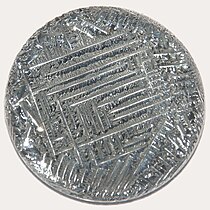
Back Chalkogeen AF Calcocheno AN काल्कोजन ANP كالكوجين Arabic Elementos del grupu 16 AST Xalkogenlər AZ Kalkogén BAN Халькагены BE-X-OLD Халкоген Bulgarian চ্যালকোজেন Bengali/Bangla
| Chalcogens | |||||||||||
|---|---|---|---|---|---|---|---|---|---|---|---|
| |||||||||||
| ↓ Period | |||||||||||
| 2 | Oxygen (O) 8 Other nonmetal | ||||||||||
| 3 | Sulfur (S) 16 Other nonmetal | ||||||||||
| 4 | Selenium (Se) 34 Other nonmetal | ||||||||||
| 5 | Tellurium (Te) 52 Metalloid | ||||||||||
| 6 | Polonium (Po) 84 Other metal | ||||||||||
| 7 | Livermorium (Lv) 116 Other metal | ||||||||||
|
Legend
| |||||||||||
The chalcogens (ore forming) (/ˈkælkədʒənz/ KAL-kə-jənz) are the chemical elements in group 16 of the periodic table.[1] This group is also known as the oxygen family. Group 16 consists of the elements oxygen (O), sulfur (S), selenium (Se), tellurium (Te), and the radioactive elements polonium (Po) and livermorium (Lv).[2] Often, oxygen is treated separately from the other chalcogens, sometimes even excluded from the scope of the term "chalcogen" altogether, due to its very different chemical behavior from sulfur, selenium, tellurium, and polonium. The word "chalcogen" is derived from a combination of the Greek word khalkos (χαλκός) principally meaning copper (the term was also used for bronze, brass, any metal in the poetic sense, ore and coin),[3] and the Latinized Greek word genēs, meaning born or produced.[4][5]
Sulfur has been known since antiquity, and oxygen was recognized as an element in the 18th century. Selenium, tellurium and polonium were discovered in the 19th century, and livermorium in 2000. All of the chalcogens have six valence electrons, leaving them two electrons short of a full outer shell. Their most common oxidation states are −2, +2, +4, and +6. They have relatively low atomic radii, especially the lighter ones.[6]
All of the naturally occurring chalcogens have some role in biological functions, either as a nutrient or a toxin. Selenium is an important nutrient (among others as a building block of selenocysteine) but is also commonly toxic.[7] Tellurium often has unpleasant effects (although some organisms can use it), and polonium (especially the isotope polonium-210) is always harmful as a result of its radioactivity.
Sulfur has more than 20 allotropes, oxygen has nine, selenium has at least eight, polonium has two, and only one crystal structure of tellurium has so far been discovered. There are numerous organic chalcogen compounds. Not counting oxygen, organic sulfur compounds are generally the most common, followed by organic selenium compounds and organic tellurium compounds. This trend also occurs with chalcogen pnictides and compounds containing chalcogens and carbon group elements.
Oxygen is generally obtained by separation of air into nitrogen and oxygen.[8] Sulfur is extracted from oil and natural gas. Selenium and tellurium are produced as byproducts of copper refining. Polonium is most available in naturally occurring actinide-containing materials. Livermorium has been synthesized in particle accelerators. The primary use of elemental oxygen is in steelmaking.[9] Sulfur is mostly converted into sulfuric acid, which is heavily used in the chemical industry.[7] Selenium's most common application is glassmaking. Tellurium compounds are mostly used in optical disks, electronic devices, and solar cells. Some of polonium's applications are due to its radioactivity.[2]
- ^ House, James E.; House, James Evan (2008). Inorganic chemistry. Amsterdam Heidelberg: Elsevier Academic Press. p. 523. ISBN 978-0-12-356786-4.
- ^ a b Emsley, John (2011). Nature's Building Blocks: An A-Z Guide to the Elements (New ed.). New York, NY: Oxford University Press. pp. 375–383, 412–415, 475–481, 511–520, 529–533, 582. ISBN 978-0-19-960563-7.
- ^ The New Shorter Oxford Dictionary. Oxford University Press. 1993. p. 368. ISBN 978-0-19-861134-9.
- ^ "chalcogen". Merriam-Webster. 2013. Retrieved November 25, 2013.
- ^ Bouroushian, M. (2010). Electrochemistry of Metal Chalcogenides. Monographs in Electrochemistry. Bibcode:2010emc..book.....B. doi:10.1007/978-3-642-03967-6. ISBN 978-3-642-03967-6.
- ^ Cite error: The named reference
Jackson2002was invoked but never defined (see the help page). - ^ a b Cite error: The named reference
The Elementswas invoked but never defined (see the help page). - ^ "Saiba como é produzido o oxigênio hospitalar". Conselho Federal de Química. February 18, 2021. Archived from the original on June 30, 2022. Retrieved December 23, 2023.
- ^ "Oxygen - Element information, properties and uses | Periodic Table". www.rsc.org. Retrieved December 5, 2024.



